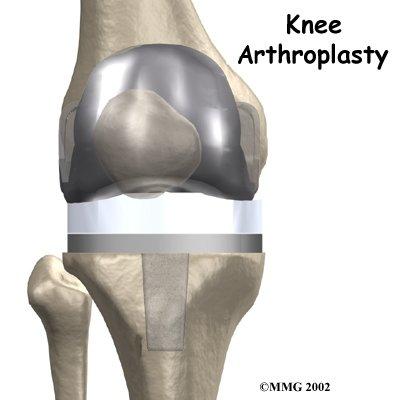Artificial Joint Replacement of the Knee

Overview
Artificial Joint Replacement of the Knee, also known as knee arthroplasty, is a surgical procedure that replaces a damaged or diseased knee joint with a prosthesis, a device designed to replicate the movement of a natural knee. This procedure is commonly performed to alleviate pain and enhance mobility in patients with severe arthritis, knee injuries, or other degenerative knee diseases.
Types
There are two primary types of knee arthroplasty:
– Total Knee Replacement (TKR): This surgery involves replacing the entire knee joint, both the thigh (femur) and shin (tibia) bones parts, with artificial metallic or plastic components.
– Partial Knee Replacement (PKR): In this procedure, only the most damaged part of the knee is replaced, preserving as much natural bone as possible.
Your doctor will discern the suitable type based on your age, overall health, knee condition, and lifestyle.
Causes
Artificial Joint Replacement of the Knee is commonly necessary due to the damage caused by knee-related conditions such as:
– Osteoarthritis, caused by wear and tear over time
– Rheumatoid arthritis, an autoimmune disorder
– Post-traumatic arthritis, following a severe knee injury
– Bone tumor in the knee
These conditions progressively damage the knee joint, causing chronic pain, swelling, and limited mobility.
Symptoms
Some common symptoms indicating the need for a knee replacement include:
– Chronic knee pain that restricts daily activities
– Moderate or severe knee pain while resting
– Long-lasting swelling or inflammation that doesn’t improve with rest or medications
– Knee deformity — a bowing in or out of your knee
– Failure to obtain pain relief from non-surgical treatments
Diagnosis
Diagnosis includes a comprehensive medical history briefing, physical examination, and various imaging tests like:
– X-Rays: To determine the extent of knee damage
– Magnetic Resonance Imaging (MRI): Provides a more detailed view of soft tissue damage in the knee
– Computer Tomography (CT) Scan: More detailed than x-rays, it allows doctors to better see the extent and location of arthritis.
Treatment Options
Treatment options vary depending on the severity of the symptoms:
– Non-Surgical Treatments: These include lifestyle modifications, physical therapy exercises, braces, over-the-counter medications like pain relievers or anti-inflammatory drugs.
– Surgical Treatments: If the non-surgical treatments fail to provide relief, a knee replacement surgery might be necessary. This major surgery is only considered when all other options have been unsuccessful.
Living With Artificial Joint Replacement of the Knee
Living with an artificial knee joint takes some adjustment but can significantly improve the quality of life:
- Physical activity: Regular low-impact exercise (like swimming or bicycling) helps to keep the new joint flexible.
– Medication management: Essential during the recovery phase. Ask your doctor how long you need to take your medications.
– Diet: Proper nutrition aids in the healing process. Incorporate a diet rich in proteins, vitamin C, D, and calcium.
When to Seek Help
Although complications are rare, you should seek immediate medical help if you experience:
– Persistent pain or swelling that doesn’t resolve
- Fever or chills, these could indicate an infection
– Sudden instability or difficulty in walking
– Noticeable redness, warmth, or tenderness, indicative of a possible blood clot.
Making informed decisions about your care are vital, understanding the process of Artificial Joint Replacement of the Knee is a step towards better management and improved quality of life.
